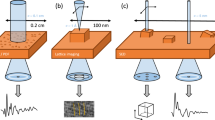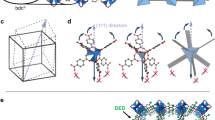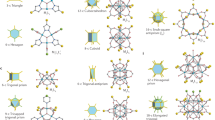Abstract
Metal-organic frameworks are a novel family of chemically diverse materials, which are of interest across engineering, physics, chemistry, biology and medicine-based disciplines. Since the development of the field in its current form more than two decades ago, priority has been placed on the synthesis of new structures. However, more recently, a clear trend has emerged in shifting the emphasis from material design to exploring the chemical and physical properties of structures already known. In particular, although such nanoporous materials were traditionally seen as rigid crystalline structures, there is growing evidence that large-scale flexibility, the presence of defects and long-range disorder are not the exception in metal-organic frameworks, but the rule. Here we offer some perspective into how these concepts are perhaps inescapably intertwined, highlight recent advances in our understanding and discuss how a consideration of the interfaces between them may lead to enhancements of the materials' functionalities.
This is a preview of subscription content, access via your institution
Access options
Subscribe to this journal
Receive 12 print issues and online access
$259.00 per year
only $21.58 per issue
Buy this article
- Purchase on Springer Link
- Instant access to full article PDF
Prices may be subject to local taxes which are calculated during checkout




Similar content being viewed by others
References
Schneermann, A. et al. Flexible metal-organic frameworks. Chem. Soc. Rev. 43, 6062–6096 (2014).
Dubbeldam, D., Walton, K. S., Ellis, D. E. & Snurr, R. Q. Exceptional negative thermal expansion in isoreticular metal-organic frameworks. Angew. Chem. Int. Ed. 46, 4496–4499 (2007).
McKellar, S. C. & Moggach, S. A. Structural studies of metal-organic frameworks under high pressure. Acta Cryst. B 71, 587–607 (2015).
Li, W. et al. Negative linear compressibility of a metal-organic framework. J. Am. Chem. Soc. 134, 11940–11943 (2012).
Cairns, A. B. et al. Giant negative linear compressibility in zinc dicyanoaurate. Nat. Mater. 12, 212–216 (2013).
Kaye, S. S., Dailly, A., Yaghi, O. M. & Long, J. R. Impact of preparation and handling on the hydrogen storage properties of Zn4O(1,4-benzenedicarboxylate)3 (MOF-5). J. Am. Chem. Soc. 129, 14176–14177 (2007).
Cooper, A. I. & Rosseinsky, M. J. Metal-organic frameworks improving pore performance. Nat. Chem. 1, 26–27 (2009).
Fang, Z. L., Bueken, B., De Vos, D. E. & Fischer, R. A. Defect-engineered metal-organic frameworks. Angew. Chem. Int. Ed. 54, 7234–7254 (2015).
Li, L. et al. A synthetic route to ultralight hierarchically micro/mesoporous Al(III)-carboxylate metal-organic aerogels. Nat. Commun. 4, 1774 (2013).
Sholl, D. S. & Lively, R. P. Defects in metal-organic frameworks: challenge or opportunity? J. Phys. Chem. Lett. 6, 3437–3444 (2015).
Hoskins, B. F. & Robson, R. Design and construction of a new class of scaffolding-like materials comprising infinite polymeric frameworks of 3D-linked molecular rods. A reappraisal of the Zn(CN)2 and Cd(CN)2 structures and the synthesis and structure of the diamond-related frameworks [N(CH3)4][CuIZnII(CN)4] and CuI[4, 4′, 4′′, 4′′′-tetracyanotetraphenylmethane]BF4·xC6H5NO2 . J. Am. Chem. Soc. 112, 1546–1554 (1990).
Bennett, T. D. et al. Hybrid glasses from strong and fragile metal-organic framework liquids. Nat. Commun. 6, 8079 (2015).
Cairns, A. B. & Goodwin, A. L. Structural disorder in molecular framework materials. Chem. Soc. Rev. 42, 4881–4893 (2013).
Ohrstrom, L. Let's talk about MOFs — topology and terminology of metal-organic frameworks and why we need them. Crystals 5, 154–162 (2015).
Loiseau, T. et al. A rationale for the large breathing of the porous aluminum terephthalate (MIL-53) upon hydration. Chem.-Eur. J. 10, 1373–1382 (2004).
Bennett, T. D. et al. Melt-quenched glasses of metal-organic frameworks. J. Am. Chem. Soc. 138, 3484–3492 (2016).
Horike, S., Shimomura, S. & Kitagawa, S. Soft porous crystals. Nat. Chem. 1, 695–704 (2009).
Wu, H., Yildirim, T. & Zhou, W. Exceptional mechanical stability of highly porous zirconium metal-organic framework UiO-66 and its important implications. J. Phys. Chem. Lett. 4, 925–930 (2013).
Valenzano, L. et al. Disclosing the complex structure of UiO-66 metal-organic framework: a synergic combination of experiment and theory. Chem. Mater. 23, 1700–1718 (2011).
Wu, H. et al. Unusual and highly tunable missing-linker defects in zirconium metal-organic framework UiO-66 and their important effects on gas adsorption. J. Am. Chem. Soc. 135, 10525–10532 (2013).
Vermoortele, F. et al. Synthesis modulation as a tool to increase the catalytic activity of metal-organic frameworks: the unique case of UiO-66(Zr). J. Am. Chem. Soc. 135, 11465–11468 (2013).
Thornton, A. W., Babarao, R., Jain, A., Trousselet, F. & Coudert, F.-X. Defects in metal-organic frameworks: a compromise between adsorption and stability? Dalton Trans. 45, 4352–4359 (2016).
Deng, H. X. et al. Multiple functional groups of varying ratios in metal-organic frameworks. Science 327, 846–850 (2010).
Fukushima, T. et al. Solid solutions of soft porous coordination polymers: fine-tuning of gas adsorption properties. Angew. Chem. Int. Ed. 49, 4820–4824 (2010).
Kleist, W., Jutz, F., Maciejewski, M. & Baiker, A. Mixed-linker metal-organic frameworks as catalysts for the synthesis of propylene carbonate from propylene oxide and CO2 . Eur. J. Inorg. Chem. 24, 3552–3561 (2009).
Cohen, S. M. Postsynthetic methods for the functionalization of metal-organic frameworks. Chem. Rev. 112, 970–1000 (2012).
Karagiaridi, O. et al. Opening ZIF-8: a catalytically active zeolitic imidazolate framework of sodalite topology with unsubstituted linkers. J. Am. Chem. Soc. 134, 18790–18796 (2012).
Deria, P. et al. Beyond post-synthesis modification: evolution of metal-organic frameworks via building block replacement. Chem. Soc. Rev. 43, 5896–5912 (2014).
Karagiaridi, O., Bury, W., Mondloch, J. E., Hupp, J. T. & Farha, O. K. Solvent-assisted linker exchange: an alternative to the de novo synthesis of unattainable metal-organic frameworks. Angew. Chem. Int. Ed. 53, 4530–4540 (2014).
Bouëssel du Bourg, L., Ortiz, A. U., Boutin, A. & Coudert, F.-X. Thermal and mechanical stability of zeolitic imidazolate frameworks polymorphs. APL Mater. 2, 124110 (2014).
Zhang, Z. Y., Li, W., Carpenter, M. A., Howard, C. J. & Cheetham, A. K. Elastic properties and acoustic dissipation associated with a disorder–order ferroelectric transition in a metal-organic framework. CrystEngComm 17, 370–374 (2015).
Hobday, C. L. et al. A computational and experimental approach linking disorder, high-pressure behavior, and mechanical properties in UiO frameworks. Angew. Chem. Int. Ed. 55, 2401–2405 (2016).
Kitagawa, S. & Kondo, M. Functional micropore chemistry of crystalline metal complex-assembled compounds. Bull. Chem. Soc. Jpn. 71, 1739–1753 (1998).
Tan, J. C. et al. Exceptionally low shear modulus in a prototypical imidazole-based metal-organic framework. Phys. Rev. Lett. 108, 095502 (2012).
Cook, T. R., Zheng, Y. R. & Stang, P. J. Metal-organic frameworks and self-assembled supramolecular coordination complexes: comparing and contrasting the design, synthesis, and functionality of metal-organic materials. Chem. Rev. 113, 734–777 (2013).
Tsuruoka, T. et al. Nanoporous nanorods fabricated by coordination modulation and oriented attachment growth. Angew. Chem. Int. Ed. 48, 4739–4743 (2009).
Xiang, S. et al. Porous organic–inorganic hybrid aerogels based on Cr3+/Fe3+ and rigid bridging carboxylates. J. Mater. Chem. 22, 1862–1867 (2012).
Lohe, M. R., Rose, M. & Kaskel, S. Metal-organic framework (MOF) aerogels with high micro- and macroporosity. Chem. Commun. 6056–6058 (2009).
Umeyama, D., Horike, S., Inukai, M., Itakura, T. & Kitagawa, S. Reversible Solid-to-liquid phase transition of coordination polymer crystals. J. Am. Chem. Soc. 137, 864–870 (2015).
Umeyama, D. et al. Glass formation via structural fragmentation of a 2D coordination network. Chem. Commun. 51, 12728–12731 (2015).
Zhao, Y., Lee, S.-Y., Becknell, N., Yaghi, O. M. & Angell, C. A. Nanoporous transparent MOF glasses with accessible internal surface. J. Am. Chem. Soc. 138, 10818–10821 (2016).
Shelby, J. E. Introduction to Glass Science and Technology 2nd edn (Royal Society of Chemistry, 2005).
Kato, H. & Kasuga, T. Preparation of proton-conducting hybrid materials by reacting zinc phosphate glass with benzimidazole. Mater. Lett. 79, 109–111 (2012).
Kim, J. & Honma, I. Anhydrous solid state proton conductor based on benzimidazole/monododecyl phosphate molecular hybrids. Solid State Ionics 176, 979–984 (2005).
Chen, W. Q. et al. Glass formation of a coordination polymer crystal for enhanced proton conductivity and material flexibility. Angew. Chem. Int. Ed. 55, 5195–5200 (2016).
Wang, L. J. et al. Synthesis and characterization of metal-organic framework-74 containing 2, 4, 6, 8, and 10 different metals. Inorg. Chem. 53, 5881–5883 (2014).
Leclerc, H. et al. Influence of the oxidation state of the metal center on the flexibility and adsorption properties of a porous metal organic framework: MIL-47(V). J. Phys. Chem. C 115, 19828–19840 (2011).
Cliffe, M. J. et al. Correlated defect nanoregions in a metal-organic framework. Nature Commun. 5, 4176 (2014).
Taylor, J. M., Dekura, S., Ikeda, R. & Kitagawa, H. Defect control to enhance proton conductivity in a metal-organic framework. Chem. Mater. 27, 2286–2289 (2015).
Tominaka, S. et al. Topochemical conversion of a dense metal-organic framework from a crystalline insulator to an amorphous semiconductor. Chem. Sci. 6, 1465–1473 (2015).
Acknowledgements
We acknowledge CECAM and CNRS for funding the Workshop on Flexibility and Disorder in Metal-Organic Frameworks (Paris, 3–5 June 2015), which spurred discussion of these topics. TDB acknowledges Trinity Hall (University of Cambridge) for funding.
Author information
Authors and Affiliations
Contributions
All authors initiated this discussion and designed the paper, T.D.B. and F.-X.C. wrote the manuscript, all authors revised it.
Corresponding authors
Ethics declarations
Competing interests
The authors declare no competing financial interests.
Rights and permissions
About this article
Cite this article
Bennett, T., Cheetham, A., Fuchs, A. et al. Interplay between defects, disorder and flexibility in metal-organic frameworks. Nature Chem 9, 11–16 (2017). https://doi.org/10.1038/nchem.2691
Received:
Accepted:
Published:
Issue Date:
DOI: https://doi.org/10.1038/nchem.2691
This article is cited by
-
Simulating the structural phase transitions of metal-organic frameworks with control over the volume of nanocrystallites
Communications Chemistry (2023)
-
Unlocked sieving potential
Nature Materials (2023)
-
Unit-cell-thick zeolitic imidazolate framework films for membrane application
Nature Materials (2023)
-
Eliminating lattice defects in metal–organic framework molecular-sieving membranes
Nature Materials (2023)
-
Synthetic control of correlated disorder in UiO-66 frameworks
Nature Communications (2023)



